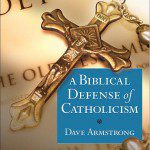John Calvin, on the other hand, takes a view much more similar to the majority of Evangelical Protestants today. He wrote, concerning John 3:5:
By “water and the Spirit,” . . . I simply understand the Spirit, which is water . . . [T]o be born again of water, and of the Spirit, is nothing else than to receive that power of the Spirit, which has the same effect on the soul that water has on the body. (Institutes, IV, 16, 25)
Titus 3:5: “[H]e saved us, not because of deeds done by us in righteousness, but in virtue of his own mercy, by the washing of regeneration and renewal in the Holy Spirit,”John 3:5: “Jesus answered, ‘Truly, truly, I say to you, unless one is born of water and the Spirit, he cannot enter the kingdom of God.’”
The two passages are almost exactly parallel:
Titus: “saved”
John: “enter the kingdom of God”Titus: “washing of regeneration”
John: “born of water”Titus: “renewal in the Holy Spirit”
John: “born of . . . the Spirit”
What is “washing” in one verse (with two other common elements) is “water” in the other. Thus, baptism is tied to salvation, in accord with the other verses above. 1 Corinthians 6:11 is also similar to Titus 3:5 and John 3:5: “And such were some of you. But you were washed, you were sanctified, you were justified in the name of the Lord Jesus Christ and in the Spirit of our God.”The “justified” is the parallel of “kingdom of God” and “saved” in Titus 3:5 and John 3:5; “washed” goes along with “washing of regeneration” and “born of water,” and all this was done by the Spirit. Now it is a striking threefold parallelism. Furthermore, it is notable that baptism, justification, and sanctification are all mentioned together. This cross-referencing supports the argument that both baptism and regeneration are the subject matter of John 3:5. I shall also answer Calvin with Luther:
Christ says clearly and concisely that the birth referred to here must take place through water and the Holy Spirit. This new birth is Baptism . . . And begone with everyone who refuses to accept this doctrine!. . . [W]e reply, “Of course, they believed that John purified by his Baptism; for by means of it he joined you to Christ.” Thus one is saved according to the way in which Christ instructed Nicodemus (John 3:5) (Sermons on the Gospel of St. John, Chapters 1-4, 1540; in LW, 22, 287-288, 429)
The analogy to John the Baptist’s baptism is interesting, and affords us more biblical parallels to John 3:5. For John, baptism was the way to the kingdom of heaven (“a baptism of repentance for the forgiveness of sins”: Mark 1:4). Christian baptism likewise forgives sins, because it regenerates. Why should an ordinary Christian baptism have less power than John’s, and not be able to wipe away sins as his did?
When Jesus arrived to begin His mission, the first thing He did was to be baptized by John (Mark 1:9), as an example (of course, he technically did not need to repent or be baptized). And what happened when Jesus was baptized? The Holy Spirit descended upon him (Mark 1:10). Thus, the Holy Spirit is present alongside the water of baptism, but is not identical to the water, as in Calvin’s view of John 3:5. Also, we see that the water preceded the Spirit, rather than vice versa, as in Calvin’s view. Cross-referencing, then, makes the baptism (and regenerational) interpretation of John 3:5 much more plausible.
How, then, does Calvin interpret Titus 3:5? He plays word games, and engages in blatant eisegesis regarding that passage and also 1 Peter 3:21:
The first object, therefore, for which it is appointed by the Lord, is to be a sign and evidence of our purification, or (better to explain my meaning) it is a kind of sealed instrument . . . [W]e are to receive it in connection with the promise, “He that believeth and is baptised shall be saved” (Mark 16:16).Peter also says that “baptism also doth now save us” (1 Pet. 3:21). For he did not mean to intimate that our ablution and salvation are perfected by water, or that water possesses in itself the virtue of purifying, regenerating, and renewing; nor does he mean that it is the cause of salvation, but only that the knowledge and certainty of such gifts are perceived in this sacrament. (Institutes, IV, 15, 1-2)
Whereas in dealing with John 3:5, Calvin allegorized the water, here he interprets the “washing” of Titus 3:5 as indeed referring to baptism (cf. Institutes, IV, 15, 5 — which only strengthens the analogies made above), but then he proceeds arbitrarily to change the function of baptism in relation to regeneration, claiming it merely follows the latter (as a sign of something already accomplished on other grounds) and does not cause it.
This theory is neat and tidy, but can it be deduced from the biblical text? If we examine just the texts mentioned in this section, Calvin’s conclusion simply does not follow. It is a forced, strained interpretation. The text of Titus reads, “he saved us, . . .by the washing of regeneration.” For Calvin’s theory to work, the RCV (Revised Calvin Version) would have to read: “The washing of regeneration is a sign and seal that he has saved us.” The two thoughts are completely different. Calvin’s logic is as absurd as the following analogy, based on the sentence structure and logic of Titus 3:5:
Text: He saved me by the throwing of a lifejacket.Interpretation: But one cannot be saved by the throwing of a life jacket, because life jacket is only a sign and symbol that one has been saved. One is already saved from drowning, and then the life jacket is thrown out to show the world that the rescuing has already occurred.
This makes no sense whatsoever. The text clearly states a particular application of the general proposition, “X was caused by Y” (or, “Y caused X” – which is the same logical proposition). The chain of causation flows from Y (baptism) to X (salvation); one cannot simply deny this (if words have any meaning); the logic and the grammatical structure of the sentence do not allow it. Calvin might better have stuck to his method of making water or washing strictly metaphorical. Once he admitted that these verses do indeed refer to baptism, he predestined himself to logical confusion and exegetical chaos.1 Peter 3:21 couldn’t be any clearer than it is: “Baptism . . . now saves you.” The RCV (applying Calvin’s exegesis) would have to read, “Baptism now gives you the knowledge and certainty of salvation.” Again, this is as logically foolish as believing that the following two sentences express the same idea:
Doctor: Heart surgery will now save your life.New Age Psychologist: Heart surgery won’t save your life but will give you the knowledge and certainty that your life is saved.
Calvin tries to explain away the baptismal regeneration of 1 Peter 3:21 by overemphasizing the “clear conscience” that Peter also mentions (see Institutes, IV, 14, 24). But I think context is decisive in upholding the Catholic interpretation of 1 Peter 3:21. We see that by adding verses 19 and 20 (as above).The meaning is much clearer in context. This is a typical Hebraic parallelism, or what is called “types and shadows”; very common in Scripture. In the Old Testament, when salvation was mentioned, it usually referred to winning a battle, being saved from an enemy, having one’s life or town saved, and so forth — in other words, physical salvation. This became a metaphor for spiritual salvation later on, in New Testament thought. Here, Peter makes the same sort of analogy. The eight persons in Noah’s ark were saved through water, i.e., physically saved from drowning. The water of the flood symbolized baptism that now saves you also, spiritually, from sin.
As Noah and his family were saved through water, so Christians are saved by baptism, not merely “symbolically saved,” or “doing a necessary but not salvific ritual after being saved, to show forth a sign and seal of our salvation,” which makes no sense of the passage and twists the parallelism itself.
Calvin plays similar games with Acts 22:16, pretending that God cannot use matter to convey His grace — that this somehow detracts from the sole sufficiency of the blood of Christ and His atonement. In other words, he denies the sacramental principle shown repeatedly in Scripture.
But he is again operating from his own preconceived notions and false dichotomies, not from the biblical data. When people like Catholics and Lutherans and Orthodox do accept the biblical evidence for baptismal regeneration in its plain meaning, Calvin treats them in the following fashion, in his comment on this verse:
It is well known how much the Papists differ from this rule, who tie the cause of grace to their exorcisms and enchantments; and they are so far from studying to direct the miserable people unto Christ, that they rather drown Christ in baptism, and pollute his sacred name by their enchantments.

















